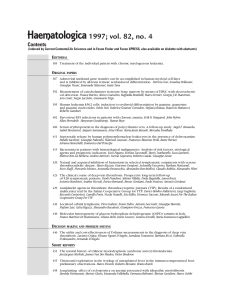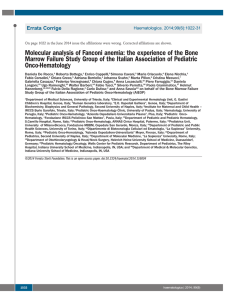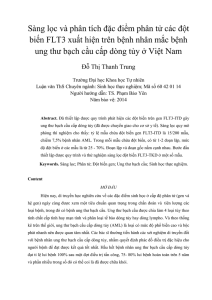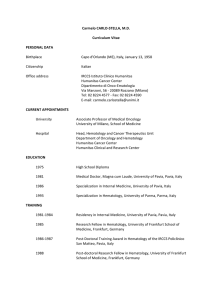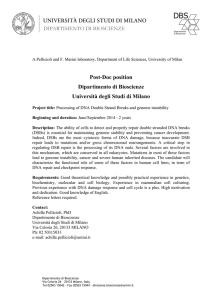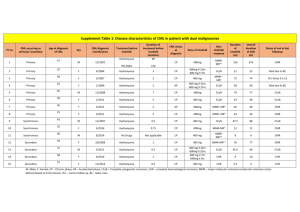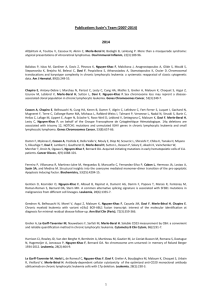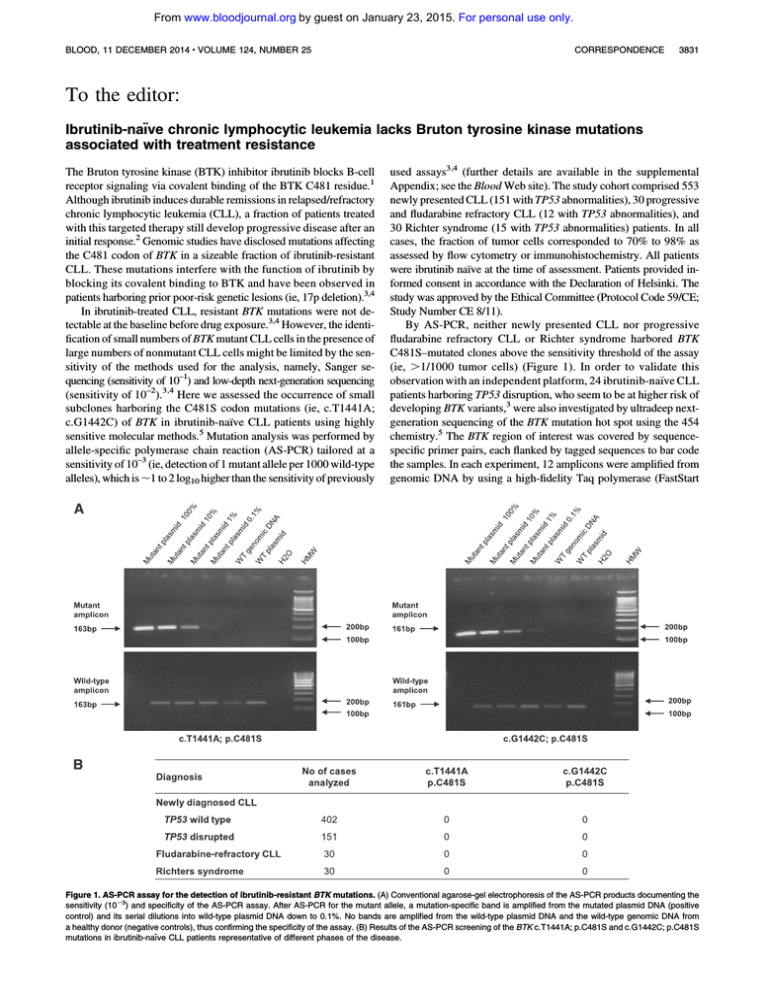
From www.bloodjournal.org by guest on January 23, 2015. For personal use only.
BLOOD, 11 DECEMBER 2014 x VOLUME 124, NUMBER 25
CORRESPONDENCE
3831
To the editor:
Ibrutinib-na¨ıve chronic lymphocytic leukemia lacks Bruton tyrosine kinase mutations
associated with treatment resistance
The Bruton tyrosine kinase (BTK) inhibitor ibrutinib blocks B-cell
receptor signaling via covalent binding of the BTK C481 residue.1
Although ibrutinib induces durable remissions in relapsed/refractory
chronic lymphocytic leukemia (CLL), a fraction of patients treated
with this targeted therapy still develop progressive disease after an
initial response.2 Genomic studies have disclosed mutations affecting
the C481 codon of BTK in a sizeable fraction of ibrutinib-resistant
CLL. These mutations interfere with the function of ibrutinib by
blocking its covalent binding to BTK and have been observed in
patients harboring prior poor-risk genetic lesions (ie, 17p deletion).3,4
In ibrutinib-treated CLL, resistant BTK mutations were not detectable at the baseline before drug exposure.3,4 However, the identification of small numbers of BTK mutant CLL cells in the presence of
large numbers of nonmutant CLL cells might be limited by the sensitivity of the methods used for the analysis, namely, Sanger sequencing (sensitivity of 10–1) and low-depth next-generation sequencing
(sensitivity of 10–2).3,4 Here we assessed the occurrence of small
subclones harboring the C481S codon mutations (ie, c.T1441A;
c.G1442C) of BTK in ibrutinib-na¨ıve CLL patients using highly
sensitive molecular methods.5 Mutation analysis was performed by
allele-specific polymerase chain reaction (AS-PCR) tailored at a
sensitivity of 10–3 (ie, detection of 1 mutant allele per 1000 wild-type
alleles), which is ;1 to 2 log10 higher than the sensitivity of previously
used assays3,4 (further details are available in the supplemental
Appendix; see the Blood Web site). The study cohort comprised 553
newly presented CLL (151 with TP53 abnormalities), 30 progressive
and fludarabine refractory CLL (12 with TP53 abnormalities), and
30 Richter syndrome (15 with TP53 abnormalities) patients. In all
cases, the fraction of tumor cells corresponded to 70% to 98% as
assessed by flow cytometry or immunohistochemistry. All patients
were ibrutinib na¨ıve at the time of assessment. Patients provided informed consent in accordance with the Declaration of Helsinki. The
study was approved by the Ethical Committee (Protocol Code 59/CE;
Study Number CE 8/11).
By AS-PCR, neither newly presented CLL nor progressive
fludarabine refractory CLL or Richter syndrome harbored BTK
C481S–mutated clones above the sensitivity threshold of the assay
(ie, .1/1000 tumor cells) (Figure 1). In order to validate this
observation with an independent platform, 24 ibrutinib-na¨ıve CLL
patients harboring TP53 disruption, who seem to be at higher risk of
developing BTK variants,3 were also investigated by ultradeep nextgeneration sequencing of the BTK mutation hot spot using the 454
chemistry.5 The BTK region of interest was covered by sequencespecific primer pairs, each flanked by tagged sequences to bar code
the samples. In each experiment, 12 amplicons were amplified from
genomic DNA by using a high-fidelity Taq polymerase (FastStart
Figure 1. AS-PCR assay for the detection of ibrutinib-resistant BTK mutations. (A) Conventional agarose-gel electrophoresis of the AS-PCR products documenting the
sensitivity (1023) and specificity of the AS-PCR assay. After AS-PCR for the mutant allele, a mutation-specific band is amplified from the mutated plasmid DNA (positive
control) and its serial dilutions into wild-type plasmid DNA down to 0.1%. No bands are amplified from the wild-type plasmid DNA and the wild-type genomic DNA from
a healthy donor (negative controls), thus confirming the specificity of the assay. (B) Results of the AS-PCR screening of the BTK c.T1441A; p.C481S and c.G1442C; p.C481S
mutations in ibrutinib-na¨ıve CLL patients representative of different phases of the disease.
From www.bloodjournal.org by guest on January 23, 2015. For personal use only.
3832
CORRESPONDENCE
High fidelity PCR System; Roche Diagnostics) and subjected to
ultradeep next-generation sequencing on a Genome Sequencer
Junior (454 Life Sciences). The target coverage was ;10 0003 per
amplicon to obtain a sensitivity of 1023 (ie, detection of 1 mutant
allele per 1000 wild-type alleles; further details are available in the
supplemental Appendix). This approach confirmed that none of the
24 TP53-disrupted CLLs harbored BTK C481S–mutated clones.
Overall, these data indicate that, among CLLs that have not been
exposed to ibrutinib, the BTK C481S variant conferring resistance
to this drug is absent or limited to a subtle fraction of the clone that
cannot be resolved with the current approaches. In this respect, CLL
differs from chronic myeloid leukemia (CML) and Ph1 acute lymphoblastic leukemia (ALL), which represent other models of mutationdriven resistance to tyrosine kinase inhibitors (TKIs). In CML and
Ph1 ALL, resistant mutations of ABL can be identified even in the
early phase of the disease in a small fraction of the tumor clone before
exposure to the selective pressure of TKI.6-8 TKI-resistant mutations
of ABL target different amino acids involved in TKI binding or in
regulatory regions of the ABL kinase domain, resulting in decreased
sensitivity to TKI while retaining aberrant kinase activity.9 At variance with ABL mutations of CML and Ph1 ALL, ibrutinib-resistant
BTK mutations in CLL (1) are selected to affect 1 single codon to
which ibrutinib covalently binds and (2) do not occur in the absence
of selective pressures imposed by ibrutinib.
From a diagnostic standpoint, our AS-PCR may serve as a new
tool for the monitoring and the early identification of treatmentemergent CLL clones harboring the ibrutinib-resistant BTK mutation,
which is one of the genetic causes of ibrutinib resistance in CLL.
Rosella Fama`
Division of Hematology, Department of Translational Medicine,
Amedeo Avogadro University of Eastern Piedmont,
Novara, Italy
Riccardo Bomben
Clinical and Experimental Onco-Hematology,
Centro di Riferimento Oncologico,
Istituto di Ricovero e Cura a Carattere Scientifico,
Aviano, Italy
Silvia Rasi
Division of Hematology, Department of Translational Medicine,
Amedeo Avogadro University of Eastern Piedmont,
Novara, Italy
Michele Dal Bo
Clinical and Experimental Onco-Hematology,
Centro di Riferimento Oncologico,
Istituto di Ricovero e Cura a Carattere Scientifico,
Aviano, Italy
Carmela Ciardullo
Division of Hematology, Department of Translational Medicine,
Amedeo Avogadro University of Eastern Piedmont,
Novara, Italy
Sara Monti
Division of Hematology, Department of Translational Medicine,
Amedeo Avogadro University of Eastern Piedmont,
Novara, Italy
Francesca Rossi
Clinical and Experimental Onco-Hematology,
Centro di Riferimento Oncologico,
Istituto di Ricovero e Cura a Carattere Scientifico,
Aviano, Italy
Tiziana D’Agaro
Clinical and Experimental Onco-Hematology,
Centro di Riferimento Oncologico,
Istituto di Ricovero e Cura a Carattere Scientifico,
Aviano, Italy
BLOOD, 11 DECEMBER 2014 x VOLUME 124, NUMBER 25
Antonella Zucchetto
Clinical and Experimental Onco-Hematology,
Centro di Riferimento Oncologico,
Istituto di Ricovero e Cura a Carattere Scientifico,
Aviano, Italy
Valter Gattei
Clinical and Experimental Onco-Hematology,
Centro di Riferimento Oncologico,
Istituto di Ricovero e Cura a Carattere Scientifico,
Aviano, Italy
Gianluca Gaidano
Division of Hematology, Department of Translational Medicine,
Amedeo Avogadro University of Eastern Piedmont,
Novara, Italy
Davide Rossi
Division of Hematology, Department of Translational Medicine,
Amedeo Avogadro University of Eastern Piedmont,
Novara, Italy
The online version of this article contains a data supplement.
Acknowledgments: This work was supported by Special Program Molecular
Clinical Oncology 5 x 1000 no. 10007, My First AIRC grant no. 13470,
Associazione Italiana per la Ricerca sul Cancro Foundation Milan, Italy;
Fondazione Cariplo, grant no. 2012-0689; Progetto Giovani Ricercatori,
grant nos. GR-2010-2317594, GR-2011-02347441, GR-2009-1475467, and
GR-2008-1138053, Ministero della Salute, Rome, Italy; Compagnia di San
Paolo, grant no. PMN_call_2012_0071, Turin, Italy; and Futuro in Ricerca 2012
grant no. RBFR12D1CB, Ministero dell’Istruzione, dell’Universita` e della
Ricerca, Rome, Italy.
Contribution: D.R., V.G., and G.G. designed the study, interpreted data, and
wrote the manuscript; and R.F., R.B., S.R., M.D.B., C.C., S.M., T.D., F.R., and
A.Z. performed and interpreted molecular studies.
Conflict-of-interest disclosure: The authors declare no competing financial
interests.
Correspondence: Davide Rossi, Division of Hematology, Department of
Translational Medicine, Amedeo Avogadro University of Eastern Piedmont,
Via Solaroli 17, 28100 Novara, Italy; e-mail rossidav@med.unipmn.it.
References
1. Woyach JA, Johnson AJ, Byrd JC. The B-cell receptor signaling pathway as
a therapeutic target in CLL. Blood. 2012;120(6):1175-1184.
2. Byrd JC, Furman RR, Coutre SE, et al. Targeting BTK with ibrutinib in relapsed
chronic lymphocytic leukemia. N Engl J Med. 2013;369(1):32-42.
3. Woyach JA, Furman RR, Liu TM, et al. Resistance mechanisms for the Bruton’s
tyrosine kinase inhibitor ibrutinib. N Engl J Med. 2014;370(24):2286-2294.
4. Furman RR, Cheng S, Lu P, et al. Ibrutinib resistance in chronic lymphocytic
leukemia [published correction appears in N Engl J Med. 2014;370(26):2547].
N Engl J Med. 2014;370(24):2352-2354.
5. Rossi D, Khiabanian H, Spina V, et al. Clinical impact of small TP53 mutated
subclones in chronic lymphocytic leukemia. Blood. 2014;123(14):2139-2147.
6. Roche-Lestienne C, Soenen-Cornu V, Grardel-Duflos N, et al. Several types of
mutations of the Abl gene can be found in chronic myeloid leukemia patients
resistant to STI571, and they can pre-exist to the onset of treatment. Blood.
2002;100(3):1014-1018.
7. Pfeifer H, Wassmann B, Pavlova A, et al. Kinase domain mutations of BCR-ABL
frequently precede imatinib-based therapy and give rise to relapse in patients
with de novo Philadelphia-positive acute lymphoblastic leukemia (Ph1 ALL).
Blood. 2007;110(2):727-734.
8. Soverini S, Vitale A, Poerio A, et al. Philadelphia-positive acute lymphoblastic
leukemia patients already harbor BCR-ABL kinase domain mutations at low
levels at the time of diagnosis. Haematologica. 2011;96(4):552-557.
9. Ernst T, La Ros ee
´ P, M uller
¨
MC, Hochhaus A. BCR-ABL mutations in
chronic myeloid leukemia. Hematol Oncol Clin North Am. 2011;25(5):
997-1008, v-vi.
© 2014 by The American Society of Hematology
From www.bloodjournal.org by guest on January 23, 2015. For personal use only.
2014 124: 3831-3833
doi:10.1182/blood-2014-08-592725
Ibrutinib-naïve chronic lymphocytic leukemia lacks Bruton tyrosine
kinase mutations associated with treatment resistance
Rosella Famà, Riccardo Bomben, Silvia Rasi, Michele Dal Bo, Carmela Ciardullo, Sara Monti,
Francesca Rossi, Tiziana D'Agaro, Antonella Zucchetto, Valter Gattei, Gianluca Gaidano and Davide
Rossi
Updated information and services can be found at:
http://www.bloodjournal.org/content/124/25/3831.full.html
Articles on similar topics can be found in the following Blood collections
Lymphoid Neoplasia (1917 articles)
Information about reproducing this article in parts or in its entirety may be found online at:
http://www.bloodjournal.org/site/misc/rights.xhtml#repub_requests
Information about ordering reprints may be found online at:
http://www.bloodjournal.org/site/misc/rights.xhtml#reprints
Information about subscriptions and ASH membership may be found online at:
http://www.bloodjournal.org/site/subscriptions/index.xhtml
Blood (print ISSN 0006-4971, online ISSN 1528-0020), is published weekly by the American Society
of Hematology, 2021 L St, NW, Suite 900, Washington DC 20036.
Copyright 2011 by The American Society of Hematology; all rights reserved.

